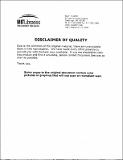| dc.contributor.advisor | Richard T. Lee and Peter T.C. So. | en_US |
| dc.contributor.author | Huang, Hayden. | en_US |
| dc.contributor.other | Harvard University--MIT Division of Health Sciences and Technology. | en_US |
| dc.date.accessioned | 2005-08-23T19:22:58Z | |
| dc.date.available | 2005-08-23T19:22:58Z | |
| dc.date.copyright | 2001 | en_US |
| dc.date.issued | 2002 | en_US |
| dc.identifier.uri | http://hdl.handle.net/1721.1/8349 | |
| dc.description | Thesis (Ph.D.)--Harvard--Massachusetts Institute of Technology Division of Health Sciences and Technology, February 2002. | en_US |
| dc.description | Includes bibliographical references (p. 99-103). | en_US |
| dc.description.abstract | A mechanotransduction model aims to explain how a cell senses mechanical forces and translates them into molecular events, such as changes in intracellular ion concentrations, gene expression, post-translational protein modification, or cytoskeletal redistribution. Many studies of mechanotransduction explore the responses of cell populations to large and, occasionally, poorly characterized deformation. More recent techniques provide the means for characterizing the physical properties of the cell, with the potential for uniting the molecular responses with the material properties and deformation characteristics of the cell. These recent techniques have an additional advantage - they can be used to probe cells at the single cell level. Single cell studies have the potential to elucidate more precisely the specific mechanisms by which a cell senses and transmits signals, because the information gathered from each cell is not averaged over thousands or millions of cells. Over the past decade, several approaches to studying mechanical properties at the single cell level were developed. Atomic force microscopy, optical and magnetic tweezers, micropipette aspiration and other techniques have been used to explore and develop physical models of the cell. By using these techniques, the basic physical response of a cell to mechanical forces has been analyzed, yet the reported cell moduli in the literature, when taken in aggregate, span up to 6 orders of magnitude. It is not clear whether this wide distribution is due to the disparity in different cell types being examined, the methods being used to stress the cell, or the models used to analyze the responses. | en_US |
| dc.description.abstract | (cont.) No study to date has addressed this variability, nor have many studies used the same physical model to test the variability of cellular mechanical properties across different cell types. To help clarify this broad variability in cellular mechanical properties, and to understand factors that may influence the responses of cells, two magnetic traps were designed to study the mechanical and molecular responses of different cell types. It was found that different cells may in fact have different mechanical properties, but the shear moduli are distributed over only one or two orders of magnitude, and not the five or six reported in the literature. Thus, the remaining variance in results is likely due to differences in modeling or technique. It is likely that differences in technique contribute substantially to the remaining variance, since molecular studies indicate that cellular responses are sensitive to environmental conditions such as temperature and to cellular conditions such as confluency. | en_US |
| dc.description.statementofresponsibility | by Hayden Huang. | en_US |
| dc.format.extent | 166 p. | en_US |
| dc.format.extent | 17152852 bytes | |
| dc.format.extent | 17152609 bytes | |
| dc.format.mimetype | application/pdf | |
| dc.format.mimetype | application/pdf | |
| dc.language.iso | eng | en_US |
| dc.publisher | Massachusetts Institute of Technology | en_US |
| dc.rights | M.I.T. theses are protected by copyright. They may be viewed from this source for any purpose, but reproduction or distribution in any format is prohibited without written permission. See provided URL for inquiries about permission. | en_US |
| dc.rights.uri | http://dspace.mit.edu/handle/1721.1/7582 | |
| dc.subject | Harvard University--MIT Division of Health Sciences and Technology. | en_US |
| dc.title | Cellular responses to mechanical stresses applied via magnetic manipulators | en_US |
| dc.type | Thesis | en_US |
| dc.description.degree | Ph.D. | en_US |
| dc.contributor.department | Harvard University--MIT Division of Health Sciences and Technology | |
| dc.identifier.oclc | 50543855 | en_US |

